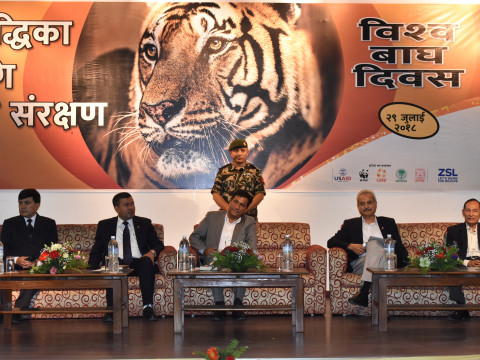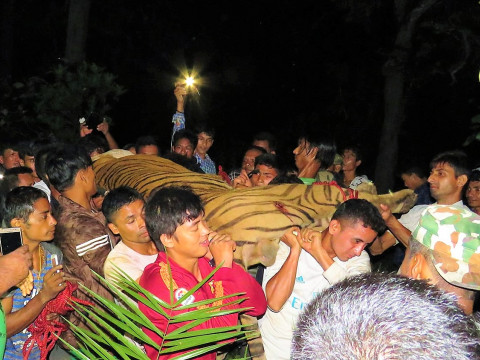
Another conflict-causing tiger has been taken under control from the Bagai area of Madi in the Chitwan National Park (CNP) area. The large cat was brought under control on August 30, 2018 after a week-long effort by a joint team of NTNC-BCC and CNP. On August 24, NTNC-BCC received information from CNP authorities regarding a fatal tiger attack on a local villager. Having killed one person, following a series of livestock attacks, it had been the cause of much terror in the area. This is the second human fatality in August this year where a tiger is seen coming outside the Park area and causing outrage.
After the man was reported to have gone missing a day earlier, a sweep operation in the Bagai community forest successfully recovered the dead body. Tragically the tiger had consumed the victim’s head and lower left limb. Upon learning this, immediately a technical team of three men were deployed for reconnaissance survey. Pugmarks indications confirmed the presence of an adult male tiger in the human settlement area. Subsequently a re-enforcement team, including staffs from NTNC-BCC and CNP, were deployed for rescue, with the Nepal Army undertaking security for the whole rescue team.
Dr. Ashish Gurung, from NTNC-BCC, shares about the difficulty of the rescue operation: “Besides the challenges of the terrain, the wounded tiger was surprisingly energetic, making the rescue even trickier.” ‘Veet and Bait’ process was used in the capture, both of which involve strategically pushing the tiger towards the narrow end of a funnel or setting up a bait, following which the tiger is tranquilized with a dart gun.
The particular tiger was found to be one of the dominant males of the area, identified from the camera traps as CNP_MT03 (tiger code) during the National Tiger Survey conducted earlier this year in January. The age of the tiger is estimated to be anywhere between 8-10 years. Recovering from the wounds on its forelimbs and torso, it would likely have succumbed to the injuries during a fight with another tiger. Its dew claw on the left forelimb was also missing. On August 31 the rescue team brought him to Kasara where it is currently being kept in the holding facility under close supervision of the wildlife veterinarian team.
In the past fiscal year in 2017-18, a total of seven human-tiger conflict incidents were reported from CNP. Two of these included livestock depredation cases, three incidents were related to human injuries and the remaining two were human fatalities. Within the first month of this fiscal year there have already been two fatal incidents with tigers in CNP.
“A majority of these cases are caused by tigers that are unable to hunt their natural prey due to injuries suffered from fights with another tiger,” suggests Mr. Babu Ram Lamichhane, another researcher at NTNC. “Other common cases include wild animals venturing out of the national park, very likely in search of its territory.” Although increasing human-tiger conflict is a major challenge for conservationists today, it is also a sign of a healthy tiger population, especially when old and weak tigers are pushed out by new stronger individuals.



